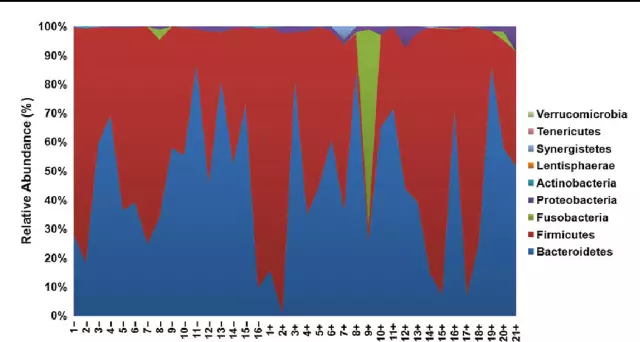- Author Rachel Wainwright [email protected].
- Public 2023-12-15 07:39.
- Last modified 2025-11-02 20:14.
Intestinal dyskinesia
The content of the article:
- Causes and risk factors
- Forms of intestinal dyskinesia
- Intestinal dyskinesia symptoms
- Features of the course of intestinal dyskinesia in children
- Diagnostics
- Intestinal dyskinesia treatment
- Diet for intestinal dyskinesia
- Possible complications and consequences
- Forecast
- Prevention
Intestinal dyskinesia is an intestinal disorder in which motor function is impaired in the absence of any organic cause. Intestinal dyskinesia is one of the most common gastroenterological pathologies; it is recorded in 15-20% of the adult population, and it has been found that approximately 2/3 of patients suffering from this disorder do not seek medical help.
Pathology can manifest itself already in childhood, including at an early age, although it often develops after 15 years, and to a greater extent women of 30-40 years old are susceptible to it. With age, the risk of intestinal dyskinesia formation decreases.
Causes and risk factors
The main cause of intestinal dyskinesia is considered to be acute or chronic stress. More susceptible to pathology of a person with a neurotic disposition, a tendency to somatization, increased anxiety, emotionally unstable.
Risk factors include:
- genetic predisposition;
- acute infectious intestinal diseases (in particular, caused by campylobacter and shigella);
- endocrine disorders;
- pathology of the central and peripheral nervous system (neoplasms and spinal cord injuries, syringomyelia, parkinsonism);
- diseases of the urogenital tract;
- inappropriate nutrition (including eating too quickly, irregular eating, eating excessively spicy, fatty, hot food);
- excessive mental stress;
- overweight;
- individual intolerance to certain foods;
- irrational use of drugs (especially antibacterial, diuretic, psychotropic drugs);
- bad habits.
Forms of intestinal dyskinesia
Intestinal dyskinesia can be primary (occurs as an independent pathology, as a rule, against the background of prolonged stress or poor nutrition) and secondary (develops against the background of another disease). The primary form of intestinal dyskinesia is more often diagnosed in children.
Depending on the consistency of the stool, intestinal dyskinesia is divided into the following forms:
- with diarrhea (more than 1/4 of all acts of defecation occur with feces of a liquid consistency, less than 1/4 with constipation);
- with constipation (more than 1/4 of all acts of defecation occur with dense and fragmented feces, less than 1/4 - with diarrhea);
- mixed (constipation and diarrhea are noted in more than 1/4 of cases);
- unclassified (changes in the consistency of feces are implicitly expressed, not enough to determine the form of pathology).
Depending on the characteristics of the clinical picture, intestinal dyskinesia is distinguished with a predominance of pain syndrome, intestinal symptoms and flatulence.
Depending on the etiological factor, intestinal dyskinesia can be stressful, alimentary (associated with errors in nutrition) or post-infectious.
Intestinal dyskinesia symptoms
All symptoms of intestinal dyskinesia are divided into those related directly to the intestines, to other organs of the gastrointestinal tract and non-gastroenterological manifestations. A feature of this disease is the absence of a tendency towards progression.
One of the main signs of intestinal dyskinesia is abdominal pain of moderate intensity, which does not have a clear localization, which occurs from time to time or regularly. It can be stabbing, cutting, dull, or aching. Most often, pain is noted in the iliac region on the left. Pain appears some time after eating, diminishes or disappears after passing gas or defecation, and never occurs at night.

Source: okeydoc.ru
Another symptom is flatulence, which appears after a certain time after eating or in the evening. Loose stools are usually observed in the morning after breakfast and absent at night. After a bowel movement, there is sometimes a feeling of incomplete bowel movement. With constipation, feces resemble sheep feces, and semi-liquid feces often come out behind dense feces. The feces may contain an admixture of mucus, but blood and pus are not found in it.
The manifestations of intestinal dyskinesia can also be an unpleasant taste in the mouth, decreased appetite.
In addition, headaches, pain in the spine, increased anxiety, panic attacks, depression, phobias, irritability, a feeling of lack of oxygen, a coma in the throat, and incomplete inhalation are often observed.
Dyskinesia and impaired duodenal patency are often accompanied by gallstone or peptic ulcer disease. At the same time, patients have spastic pain in the epigastric region, a feeling of fullness or pressure in the intestines, nausea, and vomiting.
Dyskinesia of the small intestine is characterized by spastic pains, rumbling and a feeling of transfusion in the abdomen, liquid or semi-liquid consistency of stool.
Dyskinesia of the large intestine is manifested by intestinal spasms or atony. Attacks of abdominal pain are accompanied by a bowel movement with a lot of mucus in the stool.
Features of the course of intestinal dyskinesia in children
Intestinal dyskinesia in children in the first years of life is manifested by an imperative urge to defecate, spastic pain in the abdomen or rectal area, pain often appears after physical exertion. Body weight may decrease or be gained too slowly, muscular dystrophy, anemia, and dysbiosis may appear. Children with intestinal dyskinesia are characterized by pallor of the skin, weakness, fatigue, irritability. Sometimes a slight increase in body temperature is possible.

Source: progolovy.ru
Diagnostics
For making a diagnosis, the collection of complaints and anamnesis, physical diagnostics are of primary importance. The diagnosis is made after excluding all pathologies with similar symptoms.
An ultrasound scan of the abdominal organs is performed, if necessary, a general X-ray of the abdominal cavity, X-ray examination of the large intestine with contrast (an accelerated or delayed passage of the barium mass is determined), esophagogastroduodenoscopy, sigmoidoscopy, colonoscopy, sigmoidoscopy. With dyskinesia, there are no morphological changes in the mucous membrane of the large intestine.

Source: Moscow-Doctor.rf
Laboratory diagnostics usually includes scraping for enterobiasis, analysis of feces for helminth eggs and occult blood, general and biochemical blood tests, determination of the concentration of C-reactive protein.
Differential diagnostics is carried out with infectious diseases of the gastrointestinal tract, intestinal neoplasms, malabsorption syndrome in the intestine, anomalies in the development of the intestines, endocrine diseases, gynecological pathology in women, nervous disorders, the body's response to changing dietary habits or taking medications.
Intestinal dyskinesia treatment
The main goals of therapy for intestinal dyskinesia are to eliminate symptoms and restore the patient's social activity.
The selection of medicines is carried out depending on the form of dyskinesia. With the predominance of constipation, laxatives are used to stimulate intestinal motility, increase the volume of stool, as well as osmotic laxatives. It is advisable to use drugs with two different mechanisms of action. When diarrhea predominates in the clinical picture, antidiarrheal drugs are prescribed.
With a mixed form of intestinal dyskinesia, antispasmodic and anticholinergic drugs are used. If necessary, antipsychotics and antidepressants are prescribed. General strengthening therapy, self-massage of the abdomen and physiotherapy exercises are shown, physiotherapeutic methods of treatment, acupuncture can be used. In some cases, it may be necessary to work with a psychologist or psychotherapist.
Diet for intestinal dyskinesia
One of the key points in the treatment of intestinal dyskinesia is diet. Nutrition should be balanced and complete, and at the same time gentle. The diet should include foods that stimulate (chemically and mechanically) the motor and evacuation functions of the intestine.
At the same time, it is necessary to stop eating foods that cause fermentation and putrefaction in the intestines.
Excludes alcoholic beverages, fatty meats, smoked meats, sausages, pasta, semolina, radishes, radishes, garlic, onions, baked goods made from premium flour, baked goods, chocolate, fried, spicy and spicy dishes. Limit the use of strong tea and coffee.

Source: aif.ru
Recommended: rosehip broth, compotes, jelly, rye bread, buckwheat, millet and pearl barley porridge, low-fat meat and fish, soups, hard-boiled eggs, vegetable and butter, dairy products (not recommended with a weakened intestinal tone), honey, figs, dried apricots, dates, bananas, apples, beets, carrots, cucumbers.
You can eat steamed, boiled, stewed and baked dishes. Vegetables are recommended to be consumed both raw and cooked.
It is necessary to observe the water regime - drink 1-1.5 liters of water daily, this serves to prevent constipation, and in case of diarrhea, it prevents the development of dehydration.
Possible complications and consequences
Intestinal dyskinesia can be complicated by the development of disorders from other organs of the digestive tract (gastritis, peptic ulcer, cholecystitis, cholelithiasis, neoplasms, etc.). Prolonged diarrhea can cause dehydration. In addition, intestinal dyskinesia can lead to the onset or exacerbation of depression, reduce the patient's social activity and worsen his quality of life.
Forecast
With intestinal dyskinesia, the prognosis for life is favorable, with respect to recovery - moderate.
In more than 50% of patients, the symptoms do not disappear even during the treatment, long-term remission can be achieved only in 10% of cases. The prognosis worsens with concomitant mental disorders, chronic stress, developed complications.
Prevention
There is no specific prevention of intestinal dyskinesia, since the mechanism of its development has not been clarified.
Non-specific prevention measures include:
- balanced diet;
- drinking enough fluids;
- rejection of bad habits;
- avoidance of excessive physical and mental stress;
- a rational mode of work and rest, a full night's sleep;
- sufficient physical activity;
- avoidance of irrational use of medicines, refusal of self-medication.
YouTube video related to the article:

Anna Aksenova Medical journalist About the author
Education: 2004-2007 "First Kiev Medical College" specialty "Laboratory Diagnostics".
The information is generalized and provided for informational purposes only. At the first sign of illness, see your doctor. Self-medication is hazardous to health!






